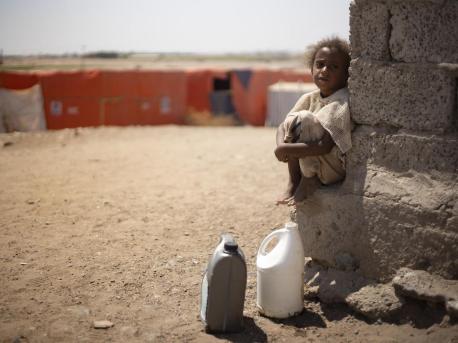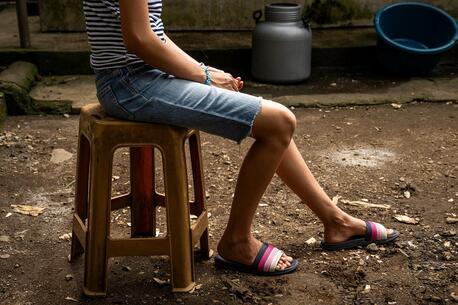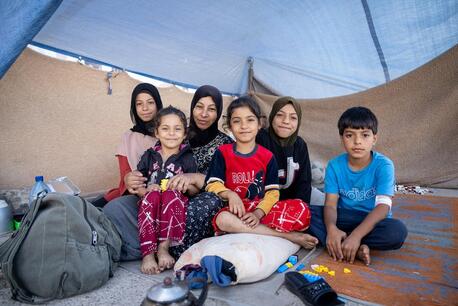
Poverty Eradication Begins With Children
Poverty is a fundamental denial of the human rights of children. Here's how UNICEF is helping every child reach her full potential.
An estimated 385 million children around the world are struggling to survive on less than $1.90 a day. Poverty is the primary cause of millions of preventable child deaths each year. It is the underlying cause of tens of millions of children being deprived of adequate education, health care, and protection against violence, child labor and forced marriage.
The cycle of poverty robs children of their childhood and their future, causing lifelong damage
The cycle of poverty robs children of their childhood and their future, causing lifelong damage. Children who do not reach their full potential cannot contribute fully to their community and society. The theme of this year’s International Day for the Eradication of Poverty, "Acting Together to Empower Children, Their Families and Communities to End Poverty," emphasizes that the first step of poverty reduction begins with the protection and realization of the human rights of children.
"One of the keys to ending child poverty is addressing poverty in the household," says United Nations Secretary-General António Guterres. "Access to quality social services must be a priority." To that end, UNICEF is working to achieve Sustainable Development Goal 1: End Poverty through education, health care and child protection.

From left: Syrian refugees Yasmeen, 8, Zainab, 9, and Mohammad, 3 wear warm winter clothes they received from UNICEF and partner Mateen in Jordan. The siblings go to a UNICEF-supported Makani center to learn and play. © UNICEF/UN0274854/Herwig
Children affected by violence and displacement are particularly likely to be living in poverty and out of school.
Displacement and poverty have disrupted the educations of a generation of Syrian children. Over one-third of Syria's child population is out of school and 1.3 million are at risk of dropping out. To help refugee children catch up on the education they've missed, UNICEF supports Makani centers where children can go to learn, transportation services to help them go to public school and self-directed learning programs for children living in hard-to-reach areas.
Over one-third of Syria's child population is out of school
Nine-year-old Zainab (above) lives with her family in an informal tented settlement in Jordan. The family fled violence in Syria six years ago. Zainab's mother, Zaela, describes life as incredibly difficult for the family. They earn $7 a day, and spend 20 percent of that on bread. “My two eldest children are our only source for food. If they don’t work, then the rest of the family will starve,” she says. “They work on a farm, harvesting vegetables. The work they do is very exhausting and not a suitable environment for children.” While her older siblings work on the farm, Zainab and the younger children go to the UNICEF Makani tent.

A UNICEF-supported community health worker in Gakenke District, Rwanda measures a child's mid-upper arm circumference during a malnutrition screening. © UNICEF/UNI212737/Rudakubana
Children living in poverty are more likely to be denied the nutrition needed for their mental and physical development. According to UNICEF's 2019 State of the World's Children report, one in three children under age 5 is too short, too thin or too heavy due to the triple burden of malnutrition: undernutrition, hidden hunger and obesity.
One in three children under age 5 suffers from malnutrition
UNICEF works with partners around the world to ensure that children get the quality nutrition they need to survive and thrive. UNICEF is the world's largest provider of Ready-to-Use Therapeutic Food (RUTF), a protein- and vitamin-rich paste used to treat severely malnourished children, and micronutrient powders (MNPs), an easy way for parents to fortify their children's meals at home.
In 2018, UNICEF and partners treated more than 4 million severely malnourished children; of those treated, four out of five children fully recovered. In Rwanda, UNICEF supports community health workers who organize monthly nutrition screenings, nutrition education talks and cooking demonstrations. Mid-upper arm circumference (MUAC) strips are used to screen for malnutrition. "If I find the children are in the 'red' zone even once, I refer them directly to the health center for treatment,” says community health worker Elisabethe (above), who works in Rwanda's Gakenke District.

Razafimandimby Olivia, 16, left school after giving birth to her son, Safidy, at age 15. Thanks to a UNICEF-supported life skills program, she has resumed her education in Ambosary, Anosy Region, Madagascar. © UNICEF/UN0325678/Ralaivita
In many countries, child poverty disproportionately affects girls. The intersection between income inequality and gender inequality puts girls in an extremely vulnerable position. Take for example the Anosy region in Madagascar where girls face the triple threat of poverty, violence and lack of access to quality education. One in two girls are forcibly married before the age of 18, and one in three girls become teenage mothers.
The intersection between income inequality and gender inequality puts girls in an extremely vulnerable position
UNICEF has been working in the region for years in close partnership with local authorities, civil societies, other UN agencies and especially with communities and adolescents. "Our interventions are done through an integrated approach to ensure that every child, especially every young girl, has access to their right to basic social services," said Elke Wisch, UNICEF Representative in Madagascar.
Razafimandimby Olivia (above) left school after giving birth to her son, Safidy, at the age of 15. Thanks to a life-skills program supported by UNICEF, she has gone back to school and is currently in 2nd grade.

A boy practices his writing skills at UNICEF-supported Mequat Primary School in Ethiopia's Tigray region. © UNICEF/UNI210665/Ayene
On the International Day for the Eradication of Poverty, let us pledge to fight the causes and outcomes of poverty to achieve our goal of No Poverty by 2030.
The world’s children need quality education, accessible health care and protection from all forms of violence to pull them out of poverty. UNICEF cannot do this alone. For any long-term solution to be achieved, world leaders, civil institutions, and individuals need to come together and act. If we act today, our children will thrive tomorrow.
Top photo: A child from Yemen's Al-Meshqafah camp takes a break while carrying heavy jugs of drinking water from supply tanks to the camp. © UNICEF/UN0320189/Baholis
HOW TO HELP
There are many ways to make a difference
War, famine, poverty, natural disasters — threats to the world's children keep coming. But UNICEF won't stop working to keep children healthy and safe.
UNICEF works in over 190 countries and territories — more places than any other children's organization. UNICEF has the world's largest humanitarian warehouse and, when disaster strikes, can get supplies almost anywhere within 72 hours. Constantly innovating, always advocating for a better world for children, UNICEF works to ensure that every child can grow up healthy, educated, protected and respected.
Would you like to help give all children the opportunity to reach their full potential? There are many ways to get involved.





